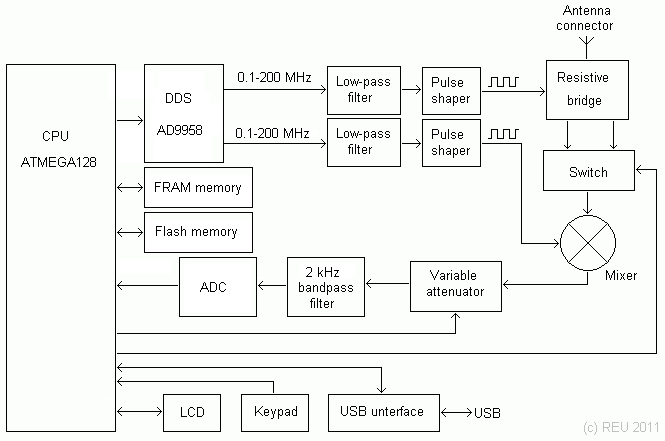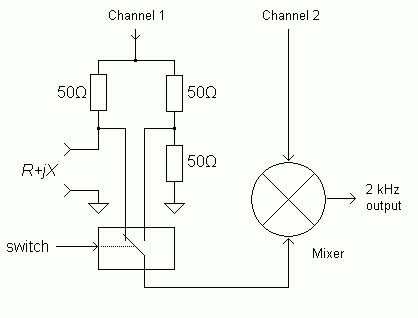RigExpert AA-1000 – How it works?
Structure diagram
The structure diagram of the RigExpert AA-600, AA-1000 and AA-1400 Antenna Analyzers is located below:

The “brain” of the analyzer is Atmel 8-bit RISC microcontroller. It controls a AD9958 DDS chip running at 500 MHz and generating two sinusoidal signals. Both signals are low-pass filtered and then put through pulse shapers, producing two square signals with LVDS levels. Resistive brigde was chosen to measure parameters of a load because of its simplicity and good frequency response. The switch commutates two outputs of the bridge. After the switch, the signal is mixed with the second channel output to produce audio frequency of 2 kHz. A variable attenuator is used to maintain the audio signal level in the desired range. This signal is then filtered and fed through the 16-bit ADC to the microcontroller. There is a simple relationship between the measurement frequency, DDS frequencies and attenuator division ratio:
| Subband | Measurement frequency |
DDS1 frequency |
DDS2 frequency |
Harmonic number |
Attenuator ratio |
| 1 (AA-600, AA-1000 and AA-1400) |
0.1 … 200 MHz | 0.1 … 200 MHz | DDS1 + 2 kHz | 1 | /25 |
| 2 (AA-600, AA-1000 and AA-1400) |
200 … 600 MHz | 67 … 200 MHz | DDS1 + 667 Hz | 3 | /3 |
| 3 (AA-1000 and AA-1400) |
600 … 1000 MHz | 120 … 200 MHz | DDS1 + 400 Hz | 5 | /1 |
| 4 (AA-1400 only) |
1000 … 1400 MHz | 142 … 200 MHz | DDS1 + 286 Hz | 7 | *2 |
The 320×240 color TFT display and the 6×3 keys keypad are connected directly to the CPU. The analyzer is equipped with 128K of external Flash memory to store measurement results, as well as with 32K of the fast external FRAM. The USB interface chip allows connecting the analyzer to the PC.
Close look at the bridge
This is a diagram of the resistive bridge and its connection to the mixer:

